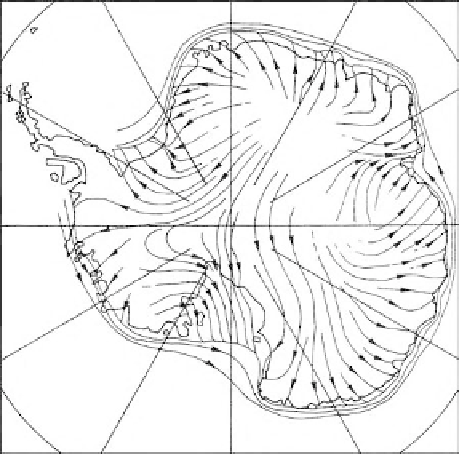Geoscience Reference
In-Depth Information
Figure 5.4 Spatial
distribution of surface wind
streamlines over Antarctica.
(From King, J. and Turner, J.,
1997
, with permission
Cambridge University Press)
the inversion is well developed. While in winter there is no systematic diurnal
cycle due to the absence of sunlight, the winds in summer are normally
stronger during nighttime. These winds blow from a prevailing direction,
normally somewhat to the left of the gravity fall line, and are represented by
streamlines in Figure
5.4
. The directional constancy, defined as the vectorial
wind divided by the sum of all winds, is frequently in excess of 0.9, surpass-
ing even the trade winds in their unchanging direction. The winds start out at
the high plateau with low speeds, accelerating on their way to the coast, and
can reach extremely high wind velocities at the coast, especially in conflu-
ence zones. Such a zone is Cape Denison in Commonwealth Bay, where
Douglas Mawson over-wintered between 1911 and 1913. He named his book
appropriately The Home of the Blizzard (Mawson
1915
). Here are some
statistics from his observations:
19.4m s
1
Mean annual wind speed
11.7m s
1
Mean of quietest month
25.8m s
1
Mean of stormiest month
36.0m s
1
Mean of stormiest day
42.9m s
1
Mean of stormiest hour
After his return to Australia, Mawson's measurements were doubted, the
instruments were recalibrated, and the values were adjusted downwards.
Recent observations with automatic weather stations (Wendler et al.
1997
)
suggest that the downwards adjustment might have been overdone. To live

Search WWH ::

Custom Search